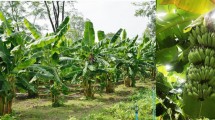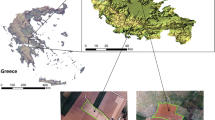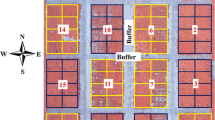Abstract
This study aims to develop prediction models for Brix, Pol, fiber, and CCS value in cane fields by using vegetation indices calculated from canopy reflectance based on images taken by a multispectral camera mounted on a small unmanned aerial system (UAS). For this purpose, a MicaSense RedEdge equipped with six-rotor UAS was used. This experiment was conducted on three sugarcane varieties, namely UT84-12 (a flood-tolerant variety), and K88-92 and KK3 (drought-tolerant varieties). The acquired images were generated into five bands of reflectance maps (blue, green, red, NIR, and rededge) in Pix4D software, which were used to produce a map of six vegetation indices (GNDVI, NDVI, RVI, CIgreen, CIrededge, and SRPIb). After that, each vegetation index value of the cropped plot was averaged. After the flight mission, average values of Brix, Pol, CCS, and fiber were measured from four randomly chosen sugarcane stalks from each variety. The six vegetation indices were paired with averaged references values to create simple linear regression models. It was found that CIrededge shows the best correlation with Pol (R2 0.77) and CCS (R2 0.68), independent of variety, while Brix models are dependent on the variety and require different vegetation indices. For instance, the Brix values of drought-tolerant K88-92 and KK3 correlate best with CIrededge, which is most sensitive to chlorophyll in canopy (R2 0.91), while the flood-tolerant variety (UT84-12) shows good correlation with SRPIb, sensitive to nitrogen leaf (R2 0.87). We found a poor correlation (R2 = 0.35–0.50) between fiber content with all six vegetation indices for all varieties.











Similar content being viewed by others
References
Bégué, Agnes, Valentine Lebourgeois, Eric Bappel, Pierre Todoroff, Anne Pellegrino, Florence Baillarin, and Bernard Siegmund. 2012. Spatio-temporal variability of sugarcane fields and recommendations for yield forecast using NDVI. International Journal of Remote Sensing 31(20): 5391–5407.
Chea, Chanreaksa, Khwantri Saengprachatanarug, Jetsada Posom, Mahisorn Wongphati, and Eizo Taira. 2019. Sugarcane canopy detection using high spatial resolution UAS images and digital surface model. Engineering and Applied Science Research 46: 312–317. https://doi.org/10.14456/easr.2019.35.
Chea, Chanreaksa, Khwantri Saengprachathanarug, Mahisorn Wongphati, Jetsada Posom, Cheerawat Nodthaisong, and Eizo Taira. 2018. Feasibility study of evaluation Brix of sugarcane using multispectral camera mounted on unmanned aerial vehicle. In The 11th Thai Society of Agricultural Engineering International Conference 2018, 148–159.
Davies, John. 1998. The causes and consequences of cane burning in Fiji’s sugar belt. The Journal of Pacific Studies 22: 1–25.
Deng, Lei, Zhihui Mao, Xiaojuan Li, Hu Zhuowei, Fuzhou Duan, and Yanan Yan. 2018. UAV-based multispectral remote sensing for precision agriculture: A comparison between different cameras. ISPRS Journal of Photogrammetry and Remote Sensing 146: 124–136. https://doi.org/10.1016/j.isprsjprs.2018.09.008.
Department of Biotechnology, Faculty of Agro-Industry, Kasesart University. 2004. Increasing the competitiveness of the sugarcane and sugar industry (In Thai). http://www.ocsb.go.th/upload/learning/fileupload/5336-1675.pdf. Accessed December 1, 2018.
Engelke, Jim. 2002. Sugarcane: measuring commercial quality. Kununurra: Department of Agriculture Western Australia, Locked Bag No. 4, Bentley Delivery Centre, WA 6983.
Gitelson, Anatoly A., Yuri Gritz, and Mark N. Merzlyak. 2003. Relationships between leaf chlorophyll content and spectral reflectance and algorithms for non-destructive chlorophyll assessment in higher plant leaves. Journal of Plant Physiology 160(3): 271–282. https://doi.org/10.1078/0176-1617-00887.
Gitelson, Anatoly A., Yoram J. Kaufman, and Mark N. Merzlyak. 1996. Use of a green channel in remote sensing of global vegetation from EOS- MODIS. Remote Sensing of Environment 58(3): 289–298. https://doi.org/10.1016/S0034-4257(96)00072-7.
Gitelson, Anatoly A., Andrés Viña, Verónica Ciganda, Donald C. Rundquist, and Timothy J. Arkebauer. 2005. Remote estimation of canopy chlorophyll content in crops. Geophysical Research Letters, 32: L08403. https://doi.org/10.1029/2005GL022688.
Grunow, M., H.O. Günther, and R. Westinner. 2007. Supply optimization for the production of raw sugar. International Journal of Production Economics 110(1): 224–239. https://doi.org/10.1016/j.ijpe.2007.02.019.
Hatfield, Jerry L., and John H. Prueger. 2010. Value of using different vegetative indices to quantify agricultural crop characteristics at different growth stages under varying management practices. Remote Sensing 2: 562–578. https://doi.org/10.3390/rs2020562.
Jiao, Zhaorong, Andrew J. Higgins, and Diane B. Prestwidge. 2005. An integrated statistical and optimisation approach to increasing sugar production within a mill region. Computers and Electronics in Agriculture 48(2): 170–181. https://doi.org/10.1016/j.compag.2005.03.004.
Jordan, Carl F. 1969. Derivation of leaf-area index from quality of light on the forest floor. Ecology 50(4): 663–666. https://doi.org/10.2307/1936256.
Le Gal, P. 2004. Value and feasibility of alternative cane supply scheduling for a South African mill supply area. South African Sugar Technologist Association Conference 78: 81–94.
Lebourgeois, V., A. Bégué, S. Labbé, M. Houlès, and J.F. Martiné. 2012. A light-weight multi-spectral aerial imaging system for nitrogen crop monitoring. Precision Agriculture 13: 525–541. https://doi.org/10.1007/s11119-012-9262-9.
MicaSense Incorporated. 2017. MicaSense RedEdge-M™ Multispectral Camera—User manual. https://support.micasense.com/hc/en-us/article_attachments/115004168274/RedEdge-M_User_Manual.pdf. Accessed December 1, 2018.
Nodthaisong, Cheerawat, Khwantri Saengprachathanarug, Chanreaksa Chea, Jetsada Posom, Seree Wongpichet, Supasit Konyai, and Mahisorn Wongphati. 2019. Feasibility study of sugarcane yield prediction using NDVI, CI rededge Indices associated with volume of digital surface model (DSM). Khon Kaen Agriculture Journal 47(4): 679–694. https://doi.org/10.14456/kaj.2019.65.
Peñuelas, J., J.A. Gamon, A.L. Fredeen, J. Merino, and C.B. Field. 1994. Reflectance indices associated with physiological changes in nitrogen- and water-limited sunflower leaves. Remote Sensing of Environment 48(2): 135–146. https://doi.org/10.1016/0034-4257(94)90136-8.
Phuphaphud, Arthit, Khwantri Saengprachatanarug, Jetsada Posom, Seree Wongpichet, Kanvisit Maraphum, and Eizo Taira. 2019a. Effects of waxy types of a sugarcane stalk surface on the spectral characteristics of visible-shortwave near infrared measurement. Engineering Journal 23 (1): 13–24.
Phuphaphud, Arthit, Khwantri Saengprachatanarug, Jetsada Posom, Kanvisit Maraphum, and Eizo Taira. 2019b. Prediction of the fibre content of sugarcane stalk by direct scanning using visible-shortwave near infrared spectroscopy. Vibrational Spectroscopy 101: 71–80. https://doi.org/10.1016/j.vibspec.2019.02.005.
Piewthongngam, Kullapapruk, Supachai Pathumnakul, and Kanchana Setthanan. 2009. Application of crop growth simulation and mathematical modeling to supply chain management in the Thai sugar industry. Agricultural Systems 102: 58–66. https://doi.org/10.1016/j.agsy.2009.07.002.
Plant Varieties Protection Department of Agriculture. 2014. Species inspection manual for Sugarcane (Saccharum officinarum) (In Thai). http://agritech.tnau.ac.in/agriculture/sugarcrops_sugarcane.html#preharvest. Accessed December 1, 2018.
Rouse, W., R.H. Haas, and D.W. Deering. 1974. Monitoring vegetation systems in the Great Plains with ERTS, NASA SP-351. In: Third ERTS-1 Symposium, vol 1, 301–317.
Salassi, M.E., J.B. Breaux, and C.J. Naquin. 2002. Modeling within-season sugarcane growth for optimal harvest system selection. Agricultural Systems 73(3): 261–278. https://doi.org/10.1016/S0308-521X(01)00081-6.
Stray, B.J., J.H. van Vuuren, and C.N. Bezuidenhout. 2012. An optimisation-based seasonal sugarcane harvest scheduling decision support system for commercial growers in South Africa. Computers and Electronics in Agriculture 83: 21–31. https://doi.org/10.1016/j.compag.2012.01.009.
Taira, Eizo, Masami Ueno, Noboru Furukawa, Atsuya Tasaki, Yuzo Komaki, Jun Ichi Nagai, and Khwantri Saengprachatanarug. 2013. Networking system employing near infrared spectroscopy for sugarcane payment in Japan. Journal of Near Infrared Spectroscopy 21: 477–483. https://doi.org/10.1255/jnirs.1081.
Thuankaewsing, S., S. Khamjan, K. Piewthongngam, and S. Pathumnakul. 2015. Harvest scheduling algorithm to equalize supplier benefits: A case study from the Thai sugar cane industry. Computers and Electronics in Agriculture 110: 42–55. https://doi.org/10.1016/j.compag.2014.10.005.
Williams, Phil. 2004. Statistical terms for evaluation of accuracy and precision. In Near-Infrared technology: Getting the best out of light: 82. Stellenbosch: AFRICAN SUN MeDIA.
Zhao, Duli, Neil C. Glynn, Barry Glaz, Jack C. Comstock, and Richard M. Johnson. 2012. Development of leaf spectral models for evaluating large numbers of sugarcane genotypes. Crop Science 52: 1837–1847. https://doi.org/10.2135/cropsci2012.01.0054.
Acknowledgements
This experiment was financially supported by Northeast Thailand Cane and Sugar Research Center; Applied Engineering for Importance Crops of the North East Research Group (AENE), Khon Kaen University. Authors are grateful to HG Robotic company, Thailand, for providing required equipment in this experiment and Northeast Thailand Cane and Sugar Research Center for providing experimental field, and Khon Kaen Field Crop Research Center for supplying chemical substance and equipment to this experimental study.
Author information
Authors and Affiliations
Corresponding author
Additional information
Publisher's Note
Springer Nature remains neutral with regard to jurisdictional claims in published maps and institutional affiliations.
Rights and permissions
About this article
Cite this article
Chea, C., Saengprachatanarug, K., Posom, J. et al. Sugar Yield Parameters and Fiber Prediction in Sugarcane Fields Using a Multispectral Camera Mounted on a Small Unmanned Aerial System (UAS). Sugar Tech 22, 605–621 (2020). https://doi.org/10.1007/s12355-020-00802-5
Received:
Accepted:
Published:
Issue Date:
DOI: https://doi.org/10.1007/s12355-020-00802-5




